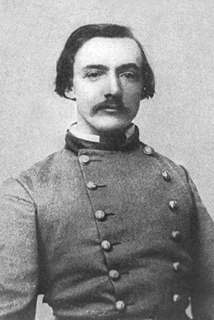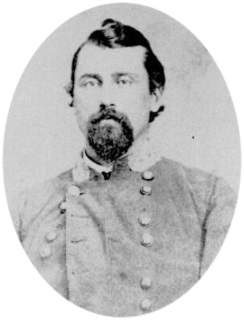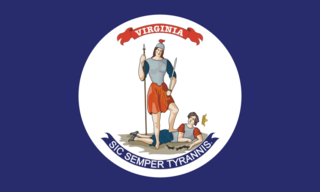
The Confederate Army of the Potomac, whose name was short-lived, was the command under Brig. Gen. P. G. T. Beauregard in the early days of the American Civil War. Its only major combat action was the First Battle of Bull Run. Afterwards, the Army of the Shenandoah was merged into the Army of the Potomac with Gen. Joseph E. Johnston, the commander of the Shenandoah, taking command. The Army of the Potomac was renamed the Army of Northern Virginia on March 14, 1862, with Beauregard's original army eventually becoming the First Corps, Army of Northern Virginia.

Adam-ondi-Ahman is a historic site in Daviess County, Missouri, about five miles south of Jameson. It is located along the east bluffs above the Grand River. According to the doctrine of The Church of Jesus Christ of Latter-day Saints, it is the site where Adam and Eve lived after being expelled from the Garden of Eden. It teaches that the place will be a gathering spot for a meeting of the priesthood leadership, including prophets of all ages and other righteous people, prior to the Second Coming of Jesus Christ.

Skirmishers are light infantry or light cavalry soldiers deployed as a vanguard, flank guard, or rearguard to screen a tactical position or a larger body of friendly troops from enemy advances. They are usually deployed in a skirmish line – an irregular open formation much more spread out in depth and breadth than a traditional line formation. Their purpose is to harass the enemy – engaging them in only light or sporadic combat in order to delay their movement, disrupt their attack, or weaken their morale; these tactics are collectively called skirmishing.

The Battle of Ball's Bluff in Loudoun County, Virginia on October 21, 1861, was one of the early battles of the American Civil War, in which Union Army forces under Major General George B. McClellan suffered a humiliating defeat.

The Battle of Chalk Bluff was a military engagement of the American Civil War. The battle was fought near Chalk Bluff, northwest of St. Francis, where U.S. Brig. Gen. Wm. Vandever, commanding the Second Division of the Army of the Frontier, was repulsed in an attempt to prevent Marmaduke's Division from crossing the St. Francis River. Though a Confederate victory, Marmaduke suffered considerable casualties and his momentum had been checked, forcing him to abandon his second expedition into Missouri.

The Ute Wars were a series of conflicts between the Ute people and the United States which began in 1849 and ended in 1923.
The Battle of Port Gibson was fought near Port Gibson, Mississippi, on May 1, 1863, between Union and Confederate forces during the Vicksburg Campaign of the American Civil War. The Union Army was led by Maj. Gen. Ulysses S. Grant, and was victorious.
The Meridian campaign or Meridian expedition took place from February 3 – March 6, 1864, from Vicksburg, Mississippi to Meridian, Mississippi, by the Union Army of the Tennessee, led by Maj. Gen. William Tecumseh Sherman. Sherman captured Meridian, Mississippi, inflicting heavy damage to it. The campaign is viewed by historians as a prelude to Sherman's March to the Sea in that a large swath of damage and destruction was inflicted on Central Mississippi as Sherman marched across the state and back.

The Battle of Chickasaw Bayou, also called the Battle of Walnut Hills, fought December 26–29, 1862, was the opening engagement of the Vicksburg Campaign during the American Civil War. Confederate forces under Lt. Gen. John C. Pemberton repulsed an advance by Union Maj. Gen. William T. Sherman that was intended to lead to the capture of Vicksburg, Mississippi.

Streight's Raid took place from April 19 to May 3, 1863, in northern Alabama. It was led by Union Col. Abel D. Streight, whose goal was to destroy parts of the Western and Atlantic Railroad, which was supplying the Confederate Army of Tennessee. The raid was poorly supplied and planned, and ended with the defeat and capture of Streight and his 1,700 men at Cedar Bluff, Alabama, by Confederate Brig. Gen. Nathan Bedford Forrest who had 500 men. Streight was additionally hindered by locals throughout his march, while pursued by Forrest, who had the advantage of home territory and the sympathy and aid of the local populace, most famously Emma Sansom.

The Battle of St. Charles was a naval engagement and infantry battle during the American Civil War. It was fought on June 17, 1862, between eight Union ships, including USS Mound City, and several Confederate shore guns. A Confederate gun hit Mound City's steam drum, causing an explosion which resulted in heavy casualties: 105 of the 175-man crew were killed. USS Mound City was then towed back to Memphis, Tennessee, and repaired.
Loudoun County in the Civil War —Loudoun County, Virginia, was destined to be an area of significant military activity during the American Civil War. Located on Virginia's northern frontier, the Potomac River, Loudoun County became a borderland after Virginia's secession from the Union in early 1861. Loudoun County's numerous Potomac bridges, ferries and fords made it an ideal location for the Union and Confederate armies to cross into and out of Virginia. Likewise, the county's several gaps in the Blue Ridge Mountains that connected the Piedmont to the Shenandoah Valley and Winchester were of considerable strategic importance. The opposing armies would traverse the county several times throughout the war leading to several small battles, most notably the Battle of Balls Bluff.

Florida had joined the Confederacy in advance of the American Civil War, as the third of the original seven states to secede from the Union, following Lincoln's 1860 election. With the smallest population, nearly half of them slaves, Florida sent only 15,000 troops to the Confederate States Army. Its chief importance was in food-supply to the south and support for blockade-runners along its long coastline full of inlets that were hard to patrol.

Adam Rankin "Stovepipe" Johnson was an antebellum Western frontiersman and later an officer in the Confederate States Army during the American Civil War. Johnson obtained notoriety leading the Newburgh Raid using a force of only about 35 men. Johnson and his men confiscated supplies and ammunition without a shot being fired by tricking Newburgh's defenders into thinking the town was surrounded by cannons. In reality, the so-called cannons were an assemblage of a stove pipe, a charred log, and wagon wheels, forever giving the Confederate commander the nickname of Adam "Stovepipe" Johnson. Permanently blinded during a skirmish in 1864, Johnson in 1887 founded the town of Marble Falls, Texas, which became known as "the blind man's town."

William Gaston Lewis was a Confederate general in the American Civil War.

The 11th Virginia Volunteer Infantry Regiment was an infantry regiment raised in Virginia for service in the Confederate States Army during the American Civil War. It fought mostly with the Army of Northern Virginia.

The Battle of Marks' Mills, also known as the Action at Marks’ Mills, was fought in present-day Cleveland County, Arkansas, during the American Civil War. Confederate Brigadier-General James F. Fagan, having made a forced march, attacked a train of several hundred wagons, guarded by a brigade of infantry, 500 cavalry, and a section of light artillery under command of Lieutenant-Colonel Francis M. Drake of the 36th Iowa, on its way from Camden to Pine Bluff for supplies.
The Battle of James Island was a minor engagement on November 14, 1782, just outside Charleston, South Carolina, between American and British forces. British troops were on the move attempting to evacuate most of the Americas. In an effort to encourage the evacuation of British troops, American forces attempted to ambush British troops cutting wood; however, reinforcements were quickly brought to the British side and the American Soldiers were forced to retreat. About 70 American troops had attempted to route and defeat British troops in the area. The British, after receiving reinforcements numbered more than 300 soldiers and vastly outnumbered the Americans. Several Americans were killed, Including Captain William Wilmont who was the last continental soldier killed in the Carolinas. In addition to Wilmont, an enslaved African American, William Smith, was taken captive by the British forces and died in British captivity As the skirmish finished the remaining American troops retreated. The British would soon withdraw from the Americas marking the end of the American Revolutionary war.
The Battle of Mount Elba, also known as Action at Mount Elba, was fought in present-day Cleveland County, Arkansas, as part of the Camden Expedition, during the American Civil War.
1st Indiana Cavalry Regiment, also known as the 28th Regiment of Volunteers was a cavalry unit that served in the Union Army during the American Civil War. Organized in August 1861, it did most of its fighting in the state of Arkansas. The regiment was in action at Cotton Plant, Helena, Bayou Fourche, Pine Bluff, Mount Elba, and Marks' Mills. One company was detached and fought in several actions in the Vicksburg campaign. The regiment was discharged in June 1865.













